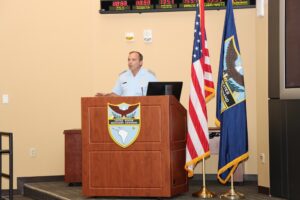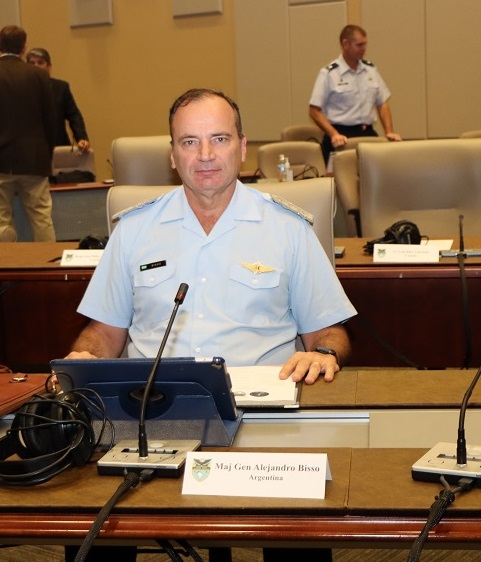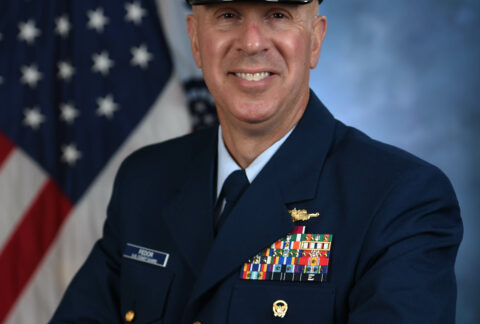The mission of the Joint Aerospace Command of the Argentine Armed Forces’ Joint Chiefs of Staff is to defend the aerospace under Argentina’s jurisdiction around the clock, 365 days a year.
This was expressed by its commander, Major General Alejandro Bisso, during the Space Conference of the Americas, held at the headquarters of U.S. Southern Command in Miami, Florida, January 30-31, 2023.
Maj. Gen. Bisso spoke with Diálogo about the mission of this important command for national security.
Diálogo: What is the greatest security challenge in terms of threats from space?
Major General Alejandro Bisso, commander of the Joint Aerospace Command of the Argentine Armed Forces’ Joint Chiefs of Staff: Argentina shares the vision of a peaceful, collaborative, and safe use of space. It’s important for us to face the challenges implied by this growing use of space, with multiple actors and multiple users. Space is a universal strategic resource. Since 1967, Argentina has been a signatory to the Space Treaty, by which we are committed to registering all our satellites. One of the main challenges is to get true situational awareness of what is happening in space, in order to maintain secure, stable, and sustainable space operations. We want to add optical sensors and radars that work together in monitoring space activity to the capabilities we already have. I would like to say that participating in this event also strengthened our aim for greater openness, cooperation, and exchange with all the participants, coordinating efforts to achieve greater space situational awareness.

Diálogo: What is your main challenge as commander?
Maj. Gen. Bisso: My main challenge is to optimize the Command and Control System of the Aerospace Command in order to exploit to the maximum the capabilities of the means that the Armed Forces put at our disposal. I say this because in Argentina, the Aerospace Command operates with means from the three Armed Forces, naturally with a greater participation from the Argentine Air Force (FAA). The sensors we use to monitor space and the aircraft we use to control it are provided to us by the Armed Forces. An important part of our task is to coordinate those means in our Command and Control System in order to get the best benefits and the greatest surveillance and control capacity for airspace and outer space.
Diálogo: The Joint Aerospace Command is one of the operational commands of the Argentine Armed Forces’ Joint Chiefs of Staff. How important is this command for national security?
Maj. Gen. Bisso: First, I would say that it provides a meaningful warning for defense. The importance lies in the fact that it is the only state agency capable of knowing and identifying air transits that do not want to be seen or identified and for which we have the capacity to act accordingly. It also works with other state agencies in developing aerospace situational awareness, which is nothing more than knowing what’s going on in aerospace as accurately as possible.
Diálogo: How do you handle the concept of interoperability?
Maj. Gen. Bisso: As far as joint interoperability is concerned, both the training of the Armed Forces personnel who work with us and the equipment we use are increasingly standardized.
In addition, after almost 10 years of existence as a joint command, we interact fluently with the civil aviation administration agencies, such as the National Civil Aviation Administration (ANAC) and the Argentine Air Navigation Company (EANA), receiving automatically all the flight plan information and air traffic radar information, which speeds up the identification process. We share the neutral information we obtain on irregular air transits with security forces, which in Argentina we call TAI, and we do it immediately.
We also have information exchange protocols with neighboring countries, the so-called Binational Aerospace Defense Standards.
Finally, we also respond to requests from our Foreign Ministry and from other government agencies.
Diálogo: What’s new in the National Aerospace Surveillance and Control System (SINVICA)?
Maj. Gen. Bisso: SINVICA was created in 2004 and its objective is to organize and optimize the surveillance and control of our airspace — all of this from the defense perspective. This required the incorporation of radars, fighter interceptors, and an integrated command and control system that coordinates these means. So far, a first stage of radarization has been successfully completed, and a second stage has already begun. In both cases, we have the additional advantage that we are mainly supplied with radars built in Argentina, by a company of the highest prestige and technological level, INVAP.
During the next quarter, we will install two more radars in northern Argentina. We will also replace in the very short term two Spanish radars that are reaching the end of their useful life and we will continue with the progressive radarization in our Patagonia, in the south of Argentina. With respect to the airplanes, which make for effective airspace control capability, both the FAA and the Ministry of Defense are evaluating new modern supersonic interceptor fighters that will help us to fulfill our mission 100 percent.
Diálogo: What advances do you have in terms of radars?
Maj. Gen. Bisso: We have excellent ties with INVAP, the company I mentioned earlier, which is manufacturing the radars. The capabilities and the scientific-technical level achieved allow us to think now about the future, that we should not only continue with the radar expansion program that’s being carried out, but we can also think about two important milestones for us, such as on-board or airborne radars and, in the not-so-distant future, satellite scanning radars, always from national industries.
Diálogo: What are the capabilities of the Joint Aerospace Command in terms of monitoring satellites of various origins that may fly over the national territory?
Maj. Gen. Bisso: The Command operates with the means made available to it by the Armed Forces to fulfill its mission, and it relates to various state agencies. The Space Identification Center, which depends on the Air Force (FAA), and which in turn interacts with the National Commission of Space Activities (CONAE), puts at our disposal extremely valuable information, which allows us to know those satellites that have some footprint or some observation capacity over our country, as well as to collaborate in the tracking of Space Debris that reenters the atmosphere.









